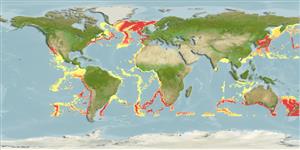Lớp phụ cá toàn đầu (Chimaera) (chimaeras) >
Chimaeriformes (Chimaeras) >
Rhinochimaeridae (Longnose chimaeras)
Etymology: Harriotta: [an]a- (L.), belonging to: per Goode & Bean (1896), in honor of Thomas Harriott (ca. 1560‒1621), English astronomer, mathematician, ethnographer and translator, who published the first English work on American natural history (1588). (See ETYFish); raleighana: In honor of Sir Walter Raleigh (ca. 1554‒1618), “philosopher and explorer, by whom the first English scientific expedition was sent to the New World” (Raleigh funded a 1585 expedition to Roanoke Island, North Carolina, with Thomas Harriott [honored in the (See ETYFish).
More on authors: Goode & Bean.
Environment: milieu / climate zone / depth range / distribution range
Sinh thái học
Biển Tầng đáy biển sâu; Mức độ sâu 200 - 3100 m (Ref. 117245), usually 500 - 2000 m (Ref. 97389). Deep-water; 65°N - 49°S, 121°W - 179°E
Cosmopolitan,
Length at first maturity / Bộ gần gũi / Khối lượng (Trọng lượng) / Age
Maturity: Lm 75.8, range 66 - 84.3 cm
Max length : 120 cm OT con đực/không giới tính; (Ref. 26346); 102.5 cm TL (female); Khối lượng cực đại được công bố: 1.6 kg (Ref. 122636)
Short description
Hình thái học | Sinh trắc học
This species is distinguished from H. chaetirhampha by the following characters: H. raleighana with eye small, its length 7% BDL (vs. 7-9% in H. chaetirhampha); interorbital space broad, 11-16% BDL (vs. 6-9%); snout tip smooth (vs. armed with small knob-like projections; only prominent in male); first dorsal fin low, length of dorsal spine anterior margin 16% BDL (vs. 19-24%); pectoral and pelvic fins broadly rounded (vs. bluntly
pointed); interdorsal space narrow, 4.5-8.4% BDL (vs. 24.8-26.8%); length of caudal dorsal margin (CDM) longer (vs. shorter) than caudal ventral margin, CDM 74-79% BDL (vs. 49-62%); length of caudal upper ray (CUR) longer (vs. shorter) than that of lower ray, CUR 10-11% BDL (vs. 4-5%); infraorbital canal strongly curved anterior to eye, forming S-shaped loop (vs. only gently curved); with distinct longer and thicker claspers, its outer length 25% BDL (vs. 16%) and its base width 3% BDL (vs. 1%); tip of the clasper excessively inflated so as to form a large, elongate and fleshy knob, covered with 16 (17 in right side) small, multifaceted, hemp-leaf shaped spines, most of which were serially arranged along its dorsomesial margin (vs. small bulb, with several simple spines sparsely distributed); a deep slit running longitudinally from dorsolateral base of rod to the ventromesial surface of the knob, running along the dorsal side of the clasper( vs. not prominent) (Ref. 123553).
Found on the continental slope and ocean floor (Ref. 26346). Appears to feed mainly on shellfish and crustaceans (Ref. 6871). Maximum length 120 cm without tail filament (Ref. 26346). It is captured as by-catch in deep water trawl fisheries (Ref. 117245).
Oviparous, young hatch at about 10-13 cm (Ref. 26346).
Last, P.R. and J.D. Stevens, 1994. Sharks and rays of Australia. CSIRO, Australia. 513 p. (Ref. 6871)
IUCN Red List Status (Ref. 130435)
Threat to humans
Harmless
Human uses
Các nghề cá: không ích lợi (thú vị)
Thêm thông tin
Các tài liệu tham khảoNuôi trồng thủy sảnTổng quan nuôi trồng thủy sảnCác giốngDi truyềnElectrophoresesDi sảnCác bệnhChế biếnNutrientsMass conversion
Các công cụ
Special reports
Download XML
Các nguồn internet
Estimates based on models
Preferred temperature (Ref.
123201): 0.3 - 9, mean 5.2 °C (based on 654 cells).
Phylogenetic diversity index (Ref.
82804): PD
50 = 0.7539 [Uniqueness, from 0.5 = low to 2.0 = high].
Bayesian length-weight: a=0.00162 (0.00122 - 0.00216), b=3.15 (3.07 - 3.23), in cm total length, based on LWR estimates for this species (Ref.
93245).
Mức dinh dưỡng (Ref.
69278): 3.6 ±0.38 se; based on food items.
Thích nghi nhanh (Ref.
120179): thấp, thời gian nhân đôi của chủng quần tối thiểu là 4.5 - 14 năm (Assuming Fec <100).
Fishing Vulnerability (Ref.
59153): High vulnerability (58 of 100).
Nutrients (Ref.
124155): Calcium = 9.59 [2.75, 33.16] mg/100g; Iron = 0.372 [0.123, 0.947] mg/100g; Protein = 14.1 [9.7, 18.1] %; Omega3 = 0.294 [0.107, 0.810] g/100g; Selenium = 23.6 [7.1, 77.7] μg/100g; VitaminA = 5.9 [1.2, 26.0] μg/100g; Zinc = 0.308 [0.158, 0.601] mg/100g (wet weight);
